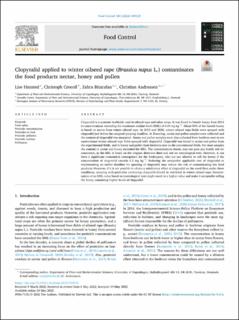| dc.contributor.author | Hansted, Lise | |
| dc.contributor.author | Crocoll, Christoph | |
| dc.contributor.author | Bitarafan, Zahra | |
| dc.contributor.author | Andreasen, Christian | |
| dc.date.accessioned | 2022-10-07T12:25:11Z | |
| dc.date.available | 2022-10-07T12:25:11Z | |
| dc.date.created | 2022-06-10T14:26:03Z | |
| dc.date.issued | 2022-05-28 | |
| dc.identifier.citation | Food Control. 2022, 140 1-7. | en_US |
| dc.identifier.issn | 0956-7135 | |
| dc.identifier.uri | https://hdl.handle.net/11250/3024527 | |
| dc.description.abstract | Clopyralid is a systemic herbicide used in oilseed rape and other crops. It was found in Danish honey from 2016 in concentrations exceeding the maximum residue level (MRL) of 0.05 mg kg−1. About 50% of the Danish honey is based on nectar from winter oilseed rape. In 2019 and 2020, winter oilseed rape fields were sprayed with clopyralid just before the assigned spraying deadline. At flowering, nectar and pollen samples were collected and the content of clopyralid was measured. Honey and pollen samples were also collected from beehives next to ten conventional winter oilseed rape fields sprayed with clopyralid. Clopyralid was found in nectar and pollen from the experimental fields, and in honey and pollen from beehives next to the conventional fields. For most samples the content in nectar and honey exceeded the MRL. The concentrations found, may not pose any health risk for consumers, as the MRL is based on the original detection limit and not on toxicological tests. However, it can have a significant economical consequence for the beekeepers, who are not allowed to sell the honey if the concentration of clopyralid exceeds 0.1 mg kg−1. Reducing the acceptable applicable rate of clopyralid or implementing an earlier deadline for spraying of clopyralid may reduce the risk of contaminating bee food products. However, if it is not possible to obtain a satisfactory effect of clopyralid on the weed flora under these conditions, spraying with pesticides containing clopyralid should be restricted in winter oilseed rape. Determination of an MRL value based on toxicological tests might result in a higher value and make it acceptable selling the honey containing higher levels of clopyralid. | en_US |
| dc.description.abstract | Clopyralid applied to winter oilseed rape (Brassica napus L.) contaminates the food products nectar, honey and pollen | en_US |
| dc.language.iso | eng | en_US |
| dc.publisher | Elsevier Ltd. | en_US |
| dc.rights | Navngivelse 4.0 Internasjonal | * |
| dc.rights.uri | http://creativecommons.org/licenses/by/4.0/deed.no | * |
| dc.title | Clopyralid applied to winter oilseed rape (Brassica napus L.) contaminates the food products nectar, honey and pollen | en_US |
| dc.title.alternative | Clopyralid applied to winter oilseed rape (Brassica napus L.) contaminates the food products nectar, honey and pollen | en_US |
| dc.type | Peer reviewed | en_US |
| dc.type | Journal article | en_US |
| dc.description.version | publishedVersion | en_US |
| dc.rights.holder | © 2022 The Authors | en_US |
| dc.source.volume | 140 | en_US |
| dc.source.journal | Food Control | en_US |
| dc.identifier.doi | 10.1016/j.foodcont.2022.109124 | |
| dc.identifier.cristin | 2030860 | |
| dc.source.articlenumber | 109124 | en_US |
| cristin.ispublished | true | |
| cristin.fulltext | original | |
| cristin.qualitycode | 1 | |

